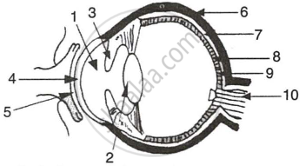Advertisements
Advertisements
प्रश्न
What is the nature of the image that forms on the retina?
उत्तर
Real, inverted and small in size
APPEARS IN
संबंधित प्रश्न
How does the eye regulate the amount of light that falls on the retina?
With the help of ciliary muscles the human eye can change its curvature and thus alter the focal length of its lens. State the changes that occur in the curvature and focal length of the eye lens while viewing (a) a distance object, (b) nearby objects.
Name the part of the eye:
on which the image is formed.
Where does the greatest degree of refraction of light occur in the eye?
What is the:
far point of a normal human eye?
Name the following:
The part of the eye responsible for its shape.
Note the relationship between the first two words and suggest the suitable word/words for the fourth place.
Cones : Iodopsim :: Rods : ______.
Mention if the following statement is true (T) or false (F) Give reason.
Ciliary muscles regulate the size of the pupil
What is meant by power of accommodation of the eye?
Name the following:
The pigmented circular area seen in the eye.
Name the following:
The type of lens used for correcting myopia.
For a normal human eye the near point is at _______.
A person cannot see distinctly objects kept beyond 2 m. This defect can be corrected by using a lens of power
______ of the eye is comparable to the film of a camera.
The innermost layer of human eye is ______.
Arrange and rewrite the term in group in correct order to be in a logical sequence, beginning with the term that is underlined:
Pupil, Aqueous humour, Retina, Vitreous humour.
Name the following:
Place of no vision in the retina of the eye.
With reference to human eye answer the question that follow:
Name the part of the eye associated with the regulation of the size of pupil.
The figure given below refers to the vertical section of the eye of a mammal. Study the figure carefully and answer the following questions.
 |
- Label the guidelines shown as 1 to 10.
- Write one important role of parts shown as 3 and 7.
- Write one structural difference between the parts shown as 9 and 10.
- Mention one functional difference between the parts shown as 6 and 8.
